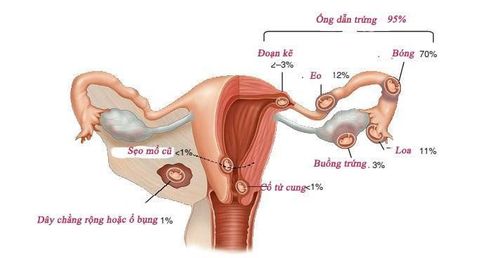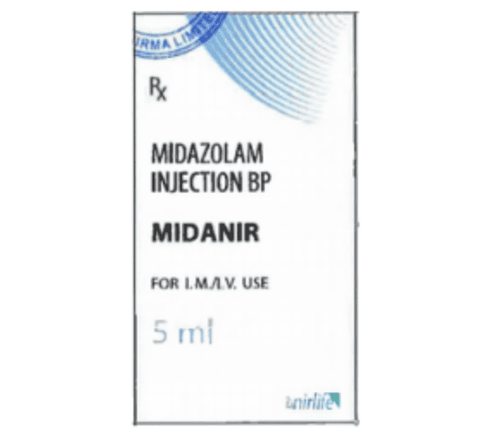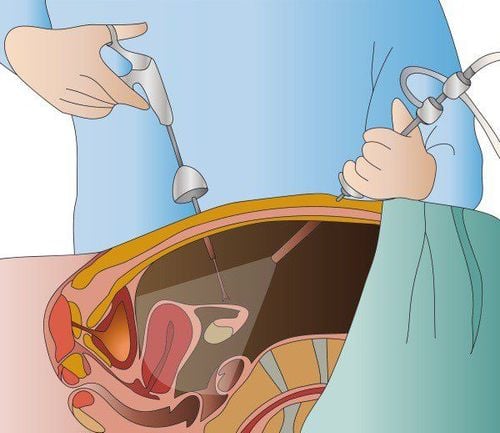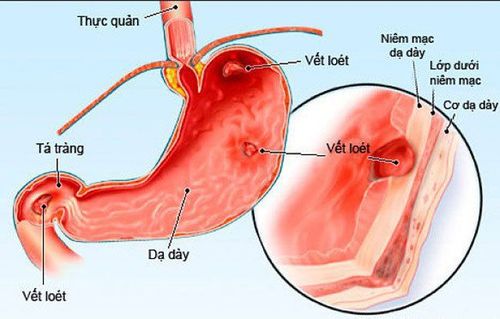This is an automatically translated article.
The article was professionally consulted by Doctor Tran Quoc Tuan - Emergency Resuscitation Doctor - Emergency Resuscitation Department - Vinmec Phu Quoc International General HospitalLaparoscopy is a surgery in which a doctor uses a laparoscope attached to a camera and light source to look inside the patient's abdomen. Compared with open surgery, laparoscopic surgery has many more advantages such as: small scars, less pain, shorter hospital stay, quick recovery, early return to work and activities. Laparoscopy is divided into two types: diagnostic laparoscopy and surgical laparoscopy.
1. What is diagnostic laparoscopy?
Diagnostic laparoscopy is a surgical procedure performed through an instrument called a laparoscope to view and illuminate the structures within the abdomen. The lamp is inserted into the abdomen through a small cut in the abdominal wall. This laparoscopy is indicated to find the cause of pain and swelling in the abdomen and pelvis or when abnormalities in these areas are detected on radiographs or CT scans. When performing this procedure, the doctor can see the abdomen clearly, some of the most common cases are:Endometriosis Pelvic infection Ectopic pregnancy Ovarian tumor Appendicitis
2. What is laparoscopy surgery?
Once everything in the abdomen is clearly visible, other instruments can be used by inserting them through other small cuts. These instruments are used to cut all or part of the structures, biopsies ... in the abdomen related to the pathology. So what is laparoscopic surgery for? Many conditions can be treated through laparoscopy surgery:Ectopic pregnancy Ovarian tumors Uterine fibroids Pathology endometriosis Infertility due to polycystic ovaries Hysterectomy Urinary incontinence, cancerous lymph node dissection,... Transmuscular loop Cholecystectomy or gallstone removal Appendectomy Partial bowel resection Biopsy of multiple abdominal organs

Thai ngoài tử cung có thể được điều trị thông qua phẫu thuật nội soi ổ bụng
3. How to perform diagnostic laparoscopy and surgery?
Both diagnostic and surgical laparoscopy are performed while the patient is anesthetized and after the abdominal skin has been cleaned. The surgeon will make small incisions near the patient's navel about 1-2cm long. A small amount of air will be injected through the cut, causing the patient's abdominal wall to stretch slightly. Then the structures in the abdominal wall will be observed more clearly, the image transmitted from the lamp will be displayed on the screen.When performing these procedures, the doctor will make one or more separate small cuts in the patient's abdominal wall through which specialized tools are inserted into the abdomen. The ends of these instruments are always seen by the doctor, through which they will be controlled and manipulated. Recently there is a new technique called single-hole laparoscopic surgery, which means that the patient only needs to make one small skin incision for the entire surgery. When finished, any surgical instruments will be removed and the skin incision will be sewn up by the doctor. More specifically:
3.1. Diagnostic laparoscopy The patient is anesthetized, then the doctor makes an incision on the abdominal skin about 8mm in the skin around the navel, through which the laparoscope and CO2 are inserted to stretch the abdomen, helping to see the internal organs clearly. inside. Next, the doctor will make an additional incision of about 5mm to insert the support instrument into the abdominal organs.
3.2. Laparoscopic surgery After endoscopic diagnosis and knowing the diseased organ, at the same time, the doctor will also perform the treatment of that organ. For example, if there is a tumor in the ovary, the doctor will remove the tumor after making 2 more skin incisions about 5mm.
4. Is laparoscopy painful?
Patients may experience redness at the incision site or pain in the apex of the shoulder due to irritation of the phrenic nerve during inflation during diagnostic laparoscopy or surgery. Specifically, shoulder pain, back pain, rib pain in the first 1-2 days and less pain in the incision. This pain will not last long, so the patient should not worry much. Recovery time will vary depending on the cause and procedure performed but will be much shorter than open surgery.Sometimes the patient feels bloated and bloated in the first 1-2 days after surgery. In addition, there may be a small amount of bleeding or discharge at the incision site in the first 1-2 days, but it is very rare. These symptoms are usually not worrisome, they can be treated with pain relievers, applying warm packs to the wound, using a clean gauze bandage...
5. Possible complications during laparoscopy
In most cases, laparoscopy leaves no significant complications. In addition to mild bruising or bleeding at the incision site, other less common complications are:Accidental damage to intra-abdominal structures such as blood vessels, then traditional surgery will be indicated. In all surgery under anesthesia, there is always a very small percentage of complications due to anesthesia. Postoperative infection.
6. Care after laparoscopic surgery like?

Uống nước sau khi tỉnh
Vinmec International General Hospital is a hospital that converges all these factors, in addition, Vinmec also has top quality services, giving patients the most secure experience when examining and treating here.
Please dial HOTLINE for more information or register for an appointment HERE. Download MyVinmec app to make appointments faster and to manage your bookings easily.













